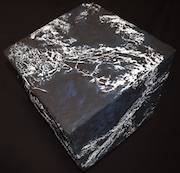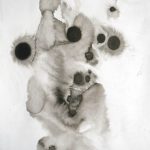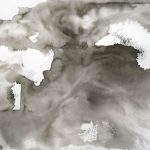Questions by Arian Hagan, a graduate student in Germany:
- Would you describe your music as ambient music?
Robert Rich: I prefer Pauline Oliveros’ phrase “Deep Listening” because it suggests a better way for a listener to approach the music. Many of my albums are too dynamic to function well as background music, although some are probably more “ambient” than others.
- If not, how would you describe it?
RR: I try not to delineate all of the music in a lump, with single-word categories, but to treat each project as an individual expression.
- What are you trying to achieve with your music? For yourself or the listener.
RR: If you insist on a word: Embodiment – a reminder of existence. In general I try to find sounds and harmonic approaches that lend to a sense of wonder and of the infinite, and also a sense of place. I try to create music with a slow seductive energy that invites the listener to explore worlds of their own imagination, and also remind them of the ground under their feet.
- What musicians would you name as influences on your sound?
RR: A long list, but near the top includes Terry Riley, Hariprasad Chaurasia, Hamza el Din, Robert Wyatt, Popol Vuh, Jon Hassell, Mark Hollis, McCoy Tyner, Lou Harrison and Javanese Gamelan in general, and many other inspirations.
- Are you influenced by visual art when creating music?
RR: Sometimes. “Bestiary” was partly influenced by the paintings of Yves Tanguy. The films of Andrey Tarkovsky often weave their mood into my music. More commonly, I experience multiple sensory modes as a gestalt, and the music refers to an almost tactile sensory experience, which also relates to visuals. My album “Tactile Ground” explores some of those aspects of synesthesia.
- When you create a piece of music, do you think about it in visual terms?
RR: Sometimes, but as mentioned above, usually in a synesthetic sense, more often tactile than visual. I do enjoy grafting visual elements onto the experience when developing artwork for each release: I enjoy that process of designing album cover art. In the creation process, I might use visual metaphors when placing sounds in the spatial field when mixing, but my senses tend to get amalgamated into a holistic sensation, and I feel the music works best when it functions energetically from the texture of the sound alone.
- Are you trying to create a specific atmosphere or “world of sound” when you produce a piece of music?
RR: Yes, for sure, but not the same atmosphere for all releases. Each project comes from its own source of inspiration, and each project manifests within its own world, its own range of moods. Often I don’t quite know what that world will sound like until it’s done. Each project bubbles up from its own underground source.
- Brian Eno presents the thesis that making music in a modern music studio is closer to the act of painting than it is to creating music in a traditional sense. What are your thoughts about that?
RR: Perhaps, but in my own case it resembles chipping slowly at stone until a sculpture takes shape. Studio recording is its own artform, really. It doesn’t have to resemble anything else. In his book “Sculpting in Time”, Andrey Tarkovsky argues for the power of what he calls the “filmic moment” – the energetic sequence of experiences that can create a specific poetry that only film can provide, with it’s multi-sensory metaphor for actually existing within the life. Likewise I think studio-created music has its own capacity to create certain moments of heightened experience, in a different idiom than (for example) live acoustic music can communicate.
- Do you agree with the phrase “the studio is my instrument”?
RR: Sure. But I also want to be good enough at some other instruments (like keyboards, flute, guitar, percussion, synthesizers) to be able to feed the studio with some good raw material. If I play something really well the first time, then I don’t have to spend days editing a mediocre performance until it is tolerable.
- How do you make music? What equipment do you use?
RR: The equipment changes from year to year. I use whatever helps me find the sound that wants to exist. My current gear list? Keyboard synths, modular synths, piano, lap steel guitar, homemade PVC and bamboo flutes, percussion, Haken Continuum, and a Mac running Logic. However, I recorded my first album 40 years ago with homebuilt electronics, a Prophet 5, bamboo flute and lap steel guitar played live to cassette. The gear doesn’t matter. The methods also change. Some of my music is almost completely improvisational, other pieces are meticulously constructed from keyboard parts, sound design and layered counterpoint.
- Please mark which of the following sources of sounds you usually use when you produce music:
RR: ALL OF THESE
(digital synthesizers / vst-plugins, analog synthesizers /keyboards, acoustic instruments, voice, field recordings, noise)
- Do you use a Digital Audio Workstation or do you strictly work using analog recording equipment?
RR: Analog from 1980-1994, Studio Vision with Protools and ADATs from 1994-2004, Logic DAW from 2004 to present.
- Do you usually work with audio recordings, midi files or both?
RR: Both
- Is the editing of audio recordings or midi-sounds part of your compositional process?
If so, are the results of editing (for example: reversing them, slowing them down, using effects like delay or reverb, etc.) just as important to the final track as the melodic, harmonic or rhythmic information that where contained in the unedited recordings?
RR: Yes, editing and processing are essential components to the sound. The original performance is also important.
- If you use synthesizers, do you prefer digital or analog ones?
RR: Doesn’t matter. Depends on the sound I want.
- Could you pick one of your compositions and describe the process of making it as detailed as you feel comfortable with? (equipment, your thoughts throughout the process, how much time you spend creating it etc.)
RR: This is difficult because there is no one method. Sometimes I release a live album where I begin building loops, and then incorporate live instruments, electronics and pre-recorded layers. If I want to have a lead melody, I usually use an acoustic or electro-acoustic instrument (like steel guitar) because I find these more expressive.
- What is important to you when you make music? Do melodies, harmony and rhythm matter to you or is it mostly about textures and sound?
RR: All of the above, although in different proportions depending on the music.
- Ambient music is sometimes thought of as music without a suspense curve or varying sections. Do you think about the structure of your pieces or are you focused on creating music that resembles a constant state?
RR: I do not ever want to make static music. Even my most slow and calm recordings avoid repetition, and move forward so that they end up in a different place than where they started. I like to offer an arc of energy.
- I noticed a contradiction in the way people talk about ambient music. On the one hand the act of listening to ambient often gets described as a state in which the listener becomes one with the sound and space surrounding him or her. And therefore makes it possible for listeners to engage more deeply with their environment.
On the other hand the music often creates a specific atmosphere that the listener can lose him or herself in, so that the music enables a form of escapism. So that the listener would actually disengage from the space they’re physically in. What are your thoughts on that?
RR: These differences come from the fact that “Ambient Music” is not one thing, it is a construct built from words and artificial categories, not from the music itself. Each artist has different intentions, and each piece or album has different intentions. Each listener has different experiences with the music, and their experiences might change when listening to the same music different times, in different states of mind. For example, I created “Somnium” and “Perpetual” to play all night long, for 7-8 hours, perhaps to journey within the dream world. Yet I hear from my audience (especially mathematicians, scientists, software engineers, artists) that many people use these at work, to help them concentrate on difficult creative tasks. When you note that listeners can “lose” themselves in the work, you could likewise note when they can “find themselves” in the work; thus making it the opposite of escapism, but rather a discovery of here and now. This difference is up to the listener. Several decades ago, I heard an interview with Steve Reich, answering a question about how the classical music establishment reacted to the repetitive tonal language that he and others were developing in the late 1960s, when the common academic language was dissonant serialism and structuralism. His answer sounded a bit defensive, because he was often attacked by academics for making anti-intellectual music. He answered something like, “You can be at a coffee shop having a conversation with someone, and hear Bach’s Goldberg Variations as background music and find it very pleasant for talking over, or you can spend years earning a doctorate analyzing The Goldberg Variations for its complex symmetries and revolutionary fugue structures. Neither approach will limit Bach to one setting or the other.” Ideally, the music should offer something useful to a listener at several different levels of attention.
- Adding to that idea, the music could be used to calm the listener and create an introspective, zen-like experience that creates inner peace. And if we accept the former thesis, ambient could actually further your engagement with your environment, even nature for example. At the same time ambient music sometimes gets criticized as being “capitalist” music, that calms but not distracts the listener while working or waiting in a line for example. What are your thoughts about that?
RR: One could argue that everything is capitalist if it offers itself for sale. I do believe that the act of listening deeply can help us notice aspects of our environment to which we may have become numb. Yearning for truth or beauty are fundamentally human, and music should speak to the human condition. I do not share the assumed intention of “ambient music” to sit in the background acting as an anesthetic; I am trying to make sonic poetry about existence and mortality, and the exquisite moments of awareness that remind us why we’re alive. Even in Brian Eno’s original formulation of “ambient” he distanced his intentions from those of Muzak, which is designed to mask the coldly built landscapes of the consumer experience and flatten the energetic cycles in the day. I think Oliveros’ intention in the phrase “Deep Listening” goes a step further, and offers a suggestion for the listener to break through the zombie-like sleepwalking of consumerist life and seek heightened sensitivity to oneself and the environment. This is about as anti-capitalist a goal that I can imagine in a world driven to distraction by social media and virtual reality. I often state my intention as “Embodiment” to set it apart from the increasingly virtualized world that media machines are building to distract us. I see virtualization as a philosophical evolution of Puritanism, a turning away from imagined “corruption” of the physical earth towards idealized “pure” spiritual abstractions. This philosophy shares roots with the belief that the earth belongs to humans for their use and consumption, which justifies capitalism and the subsequent denigration of our environment. Embodiment requires sensitivity to the fragile systems that support us on the planet, that maintain life. Embodiment places us within the environment, not above it, and asks us to embrace our own mortality.
- Eno describes his music as functioning like a river, a seemingly endless flow that changes in subtle ways or describes it like a painting on the wall that creates an atmosphere that the listener is free to concentrate on or ignore. Do you share a similar vision of your own music?
RR: Not quite, no. I tend to find those pieces tedious.
- Would it be fine with you if someone would play your music in the background or is it important to you that they actively listen?
RR: People can listen however they wish, but they will get more from it if they pay attention.
- Earlier I asked about your influences. Originally ambient music was inspired by ideas stemming from Minimalism, asian and african music and cultural practises, production techniques and sounds that were inspired by the german “Krautrock”-scene and in case of Eno even abstract paintings. Do you see yourself as being part of that tradition?
RR: Yes, I suppose so. I think psychedelic culture in the ‘60s had a lot to do with the movements you list. Also, the introduction of Japanese Zen Buddhism to the west in the 1950s, affecting composers like John Cage, with interpreters like Alan Watts and translators like DT Suzuki bringing those ideas to younger people in North America and Europe. Perhaps the two World Wars introduced more westerners to non-western cultures, through forced travel and rebuilding; and the technological advances of the 20th century continued to spread new ideas increasingly fast.
- Do you sometimes imagine making film soundtracks when you create a piece of music?
RR: Rarely if ever. I want the music to stand on its own, rather than serve a picture; or perhaps to help listeners create their own mental images.
- Do you sometimes create systems that help you create music?
RR: Sometimes, but usually not stochastic. I do use mathematical ideas rather often though.
- Ambient music is often created using loops. Eno once said: “Repetition is a form of change”. The idea is that it allows the listener to get deeper into the music with every repetition. Do you agree with that idea?
RR: I like repetition best when it doesn’t actually repeat.
- Do you specifically do things to “add information” to sounds, like adding noise or using live recordings specifically because they might have more “nuances” or “depth”?
RR: I will do whatever it takes to make a sound interesting. I don’t have any recipes.






You must be logged in to post a comment.